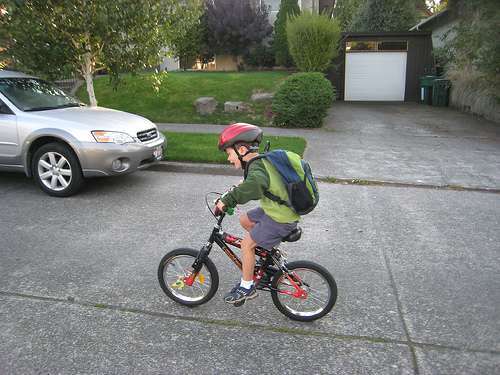Footpaths and parks support active school commute

While it probably won't make the idea of attending school more appealing social scientists say different infrastructure and behaviour change programs are key to encouraging young people to take a more active route to school.
In an Australian first, a three-year study involving Curtin University and University of Western Australia scientists is focusing on comparing children's travel in four urban regions in the country.
Curtin University researchers Dr Carey Curtis and Dr Courtney Babb selected nine schools with children aged nine to 12 years to represent a range of built environment types including an inner urban area, a middle suburb, an outer master planned community and a regional centre.
Beginning in 2011 and completed in 2014, the study was inaugurated by urban planners and public health researchers due to concerns about a decrease in children's independent travel.
Dr Curtis says many of the participant households were supportive of active travel to school, yet they lived outside of a walkable school catchment.
"Planners therefore need to improve links to other places in the neighbourhood that are potential destinations for children's active travel such as parks, recreation centres, farmers markets and local shops," she says.
Distance to school is a critical factor with the inevitability of school enrolment catchments increasing in size.
School proximity a critical factor
"It means the walk to school is not feasible for many children," Dr Curtis says.
"Cycling could be an option for children living outside of the walkable school catchment, however very few children reported usually cycling to school."
The walkability of street networks is another factor relating to a decrease in children's independent travel, with the study finding many poorly connected footpaths around schools.
Dr Curtis says, children who are less active are also more likely to have parents placing restrictions on their travel.
"Social norms are important. There were distinct differences between a group of households we label 'free range' [children who were largely mobile]…and 'bubble wrapped' [children who were restricted in their travel]," she says.
However, she says in denser areas there are more children living within feasible walking or cycling distance to school and are therefore more likely to be supportive of walking.
"They have connected streets and more supportive infrastructure," she says.
"There are also more opportunities for children to walk with friends in dense urban areas, which is an important factor parents take into account when deciding whether or not to let their children walk to school."
More information: "Built environment and children's travel to school," Transport Policy, Volume 42, August 2015, Pages 21-33, ISSN 0967-070X, dx.doi.org/10.1016/j.tranpol.2015.04.003

















